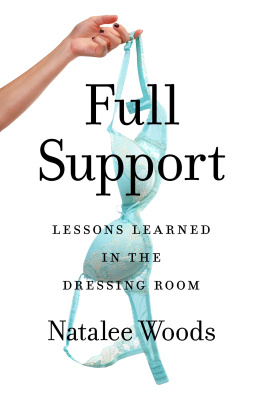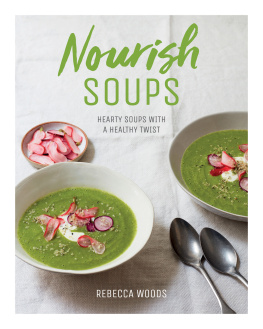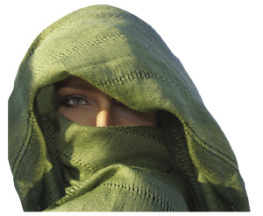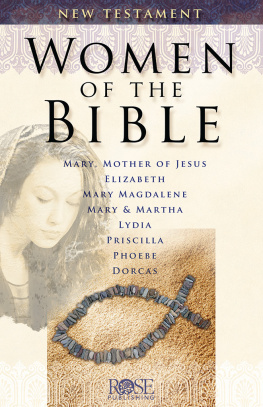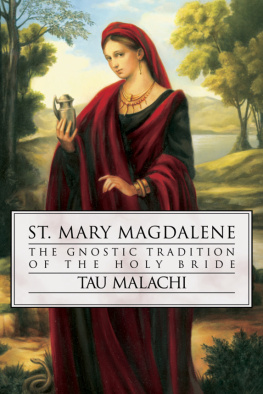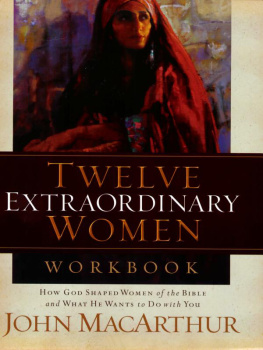Copyright 2016
Written by Len Woods
Published by B&H Publishing Group, Nashville, TN
ISBN: 978-1-4336-4447-4
Dewey Decimal Classification: 220.92 Subject Heading: WOMEN / BIBLEBIOGRAPHY \ WOMEN IN THE BIBLE
All rights reserved. No portion of this book may be reproduced, stored in a retrieval system, or transmitted in any form or by any meanselectronic, mechanical, photocopy, recording, scanning, or otherexcept for brief quotations in critical reviews or articles, without the prior written permission of the publisher.
All Scripture quotations are taken from the HCSB, Copyright 1999, 2000, 2002, 2003, 2009 by Holman Bible Publishers. Used by permission. HCSB is a federally registered trademark of Holman Bible Publishers.
Interior Design and Typesetting: Hudson Bible
Printed in China
15 16 17 18 19 8 7 6 5 4 3 2 1
RRD
Introduction
It begins with a character, usually, and once he stands up on his feet and begins to move, all I can do is trot along behind him with a paper and pencil trying to keep up long enough to put down what he says and does. William Faulkner
Faulkners words about writing fiction are also true for reading divine truth.
For all its emphasis on religious places and holy ideas, the Bible, in the final analysis, is about characters. It begins with a characterthe triune God. It then proceeds to tell one great story made up of countless smaller stories. At the heart of all this action, on every page of Scripture, we meet fascinating, real-life people. These are characters worth our time and attention.
31 Women of the Bible has been written to remind readers of Scripture of three great truths:
- Women have played an indispensable role in the great story of God. Though the Bible is without question dominated by towering male figures like Abraham, Moses, David, Pilate, and Paul, its far from a sexist book (as some have charged). From Sarah to Mary and from Esther to Elizabeth, a number of the most important heroes of the Christian faith were female.
- Bible people were flawed, flesh-and-blood folksnot unlike us. We have a tendency to idealize Scriptural saints; however, its not necessary to either romanticize or idolize them to appreciate them. (Its also not healthy!)
- The most vivid and valuable lessons come not from a lecture but from a life.
In the pages that follow, youll find:
- A concise summary of each womans appearance in Scripture, viewed through the lens of our modern culture
- Surprising revelations that may cause you to rethink what you thought you knew about each woman
- Bible passages, ripe for memorization, that capture the essence of each womans experience
- Helpful prompts for applying the principles of each womans story to your own life
- Thought-provoking questions to help you find common ground with the heroes of the Christian faith
Our hope is that as you trot along behind the thirty-one women featured in these pages, noting what each says and does, youll be able to keep up long enough to be challenged, encouraged, warned, and helped.
A woman who fears the Lord will be praised. Proverbs 31:30
E ve enjoys the distinction of being the first woman in all of human history . Talk about special.
When God decided to make human creatures in His own image (Gen 1:27), he created the male first (see Gen 2:7). A few verses later we read, Then the Lord God said, It is not good for the man to be alone. I will make a helper as his complement (Gen 2:18).
Some regard this statement as demeaningto Eve in particular, and all women in general. Nothing could be further from the truth. In calling Eve Adams helper, God used a word thats employed elsewhere in the Old Testament to speak of God himself as the uplifting helper of his people (Deut 33:7, 26; Pss 33:20; 70:5; 115:9, 10, 11; 146:5). Eve was Gods very tangible way of saying, Adam, you need help!
And such help! The verb make means to fashion. In other words, Adams new helper would be a work of art by the ultimate Creator. It gets even better. The word complement means suitable or corresponding to. The idea is that Eve would fit Adam like a jigsaw puzzle piece. She would supply strengths he lacked, and vice versa. Ultimately, Eve would be the very good solution (Gen 1:31) to Adams not good solitary existence.
And so it was. God crafted this exquisite creature to help and to complement Adam. As the first human female companion and wife, Eve experienced wonders in life none of us can fathom: glorious face-to-face walks and talks with God, marriage as it was meant to be, creation in all its piercing beauty and none of its brokenness.
How long did this perfect bliss last? A few weeks? Only a weekend? However long it was, Eve had it. She tasted it. Then, inexplicably, she gave in to the desire to taste something more. Therein lies the great liars great lie: even perfection is not enough.
Genesis 3 tells the tragic and mysterious story of how Eve was approached, tempted, and ultimately deceived by the serpent (or Satan, see 2 Cor 11:3). He somehow aroused within her a nagging doubt about Gods good heart. Or else he manipulated Eves identity as one who resembled God into a desire to replace God. However he did it, the evil one convinced Eve to defy her Creator. But before we put a disproportionate amount of blame on Eves shoulders, the Bible makes it clear that her husband, Adam, was with her (Gen 3:6). For incomprehensible reasons, he stood by passively, saying and doing nothing as his wife debated with the devil. She had barely swallowed the forbidden fruit before he was chewing it too.

Talk about tragic. The result was exactly what God had warneddeath. The immediate death of innocence, intimacy, and peace. The catastrophic end to a harmonious relationship with God, with others, with creation itself. Gone were virtues like vulnerability, trust, and selflessness. Expulsion from Eden followed, meaning a loss of access to God and to the tree of life. Adam and Eve could only look back over their shoulders at paradise and wonder what might have been.
Post-Eden, they did their best to carve out a new life. Eve became a mom to three sons: Cain, Abel, and Seth (and surely to daughters as well). At some point she faced the parental nightmare of having to bury her secondborn. Making this tragic situation worse was the fact that Abels death came at the hands of his big brother.
How or when or where Eve died, God alone knows. How tragic that this special woman, the mother of all the living, also played a prominent role in bringing death into the world.
In a sense, Eves life prefigures every life. Each one will be special. Beautiful. Marked by doubt and disobedience. Marred by the tragedy of sin and utterly dependent on the One who is able to reverse its curse.
The Takeaway
From Eves beautiful and tragic experience, we glean a couple of truths.
One, life works best when we trust and obey the explicit Word of God. We have an enemy who uses deceit in order to destroy (see John 8:44; 1 Pet 5:8). Since we are continually subjected to a chorus of competing voices, we have to be careful. We can know the enemy is at work when we find ourselves entertaining the notion that Gods heart is suspect, that his way is restrictive, and that doing his will leads to a diminished life. The devil is crafty. He is able to speak even through well-intentioned people (see Mark 8:3133). Its only because, in the words of Martin Luther, the right man [is] on our side that we are able to stand against his enticements.



